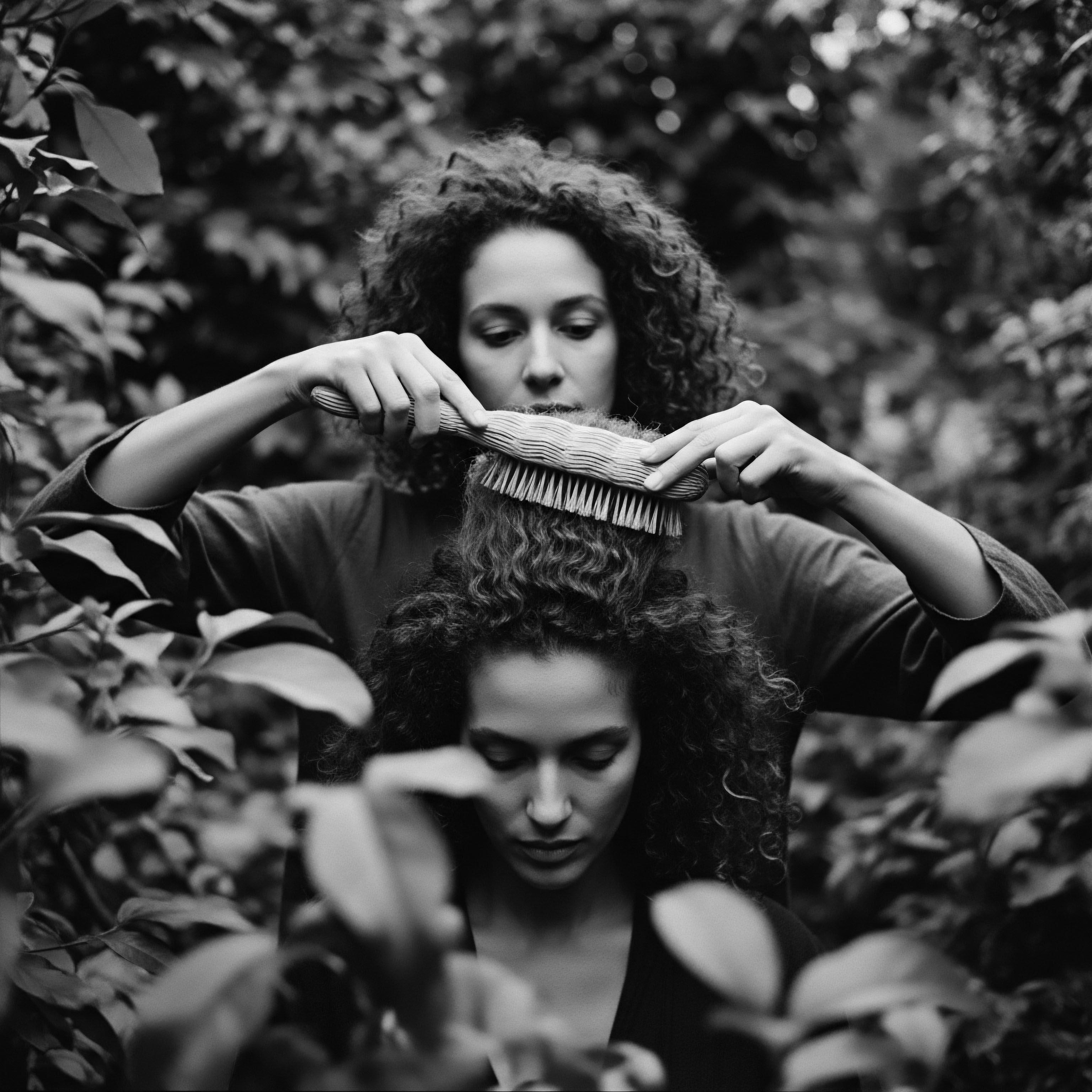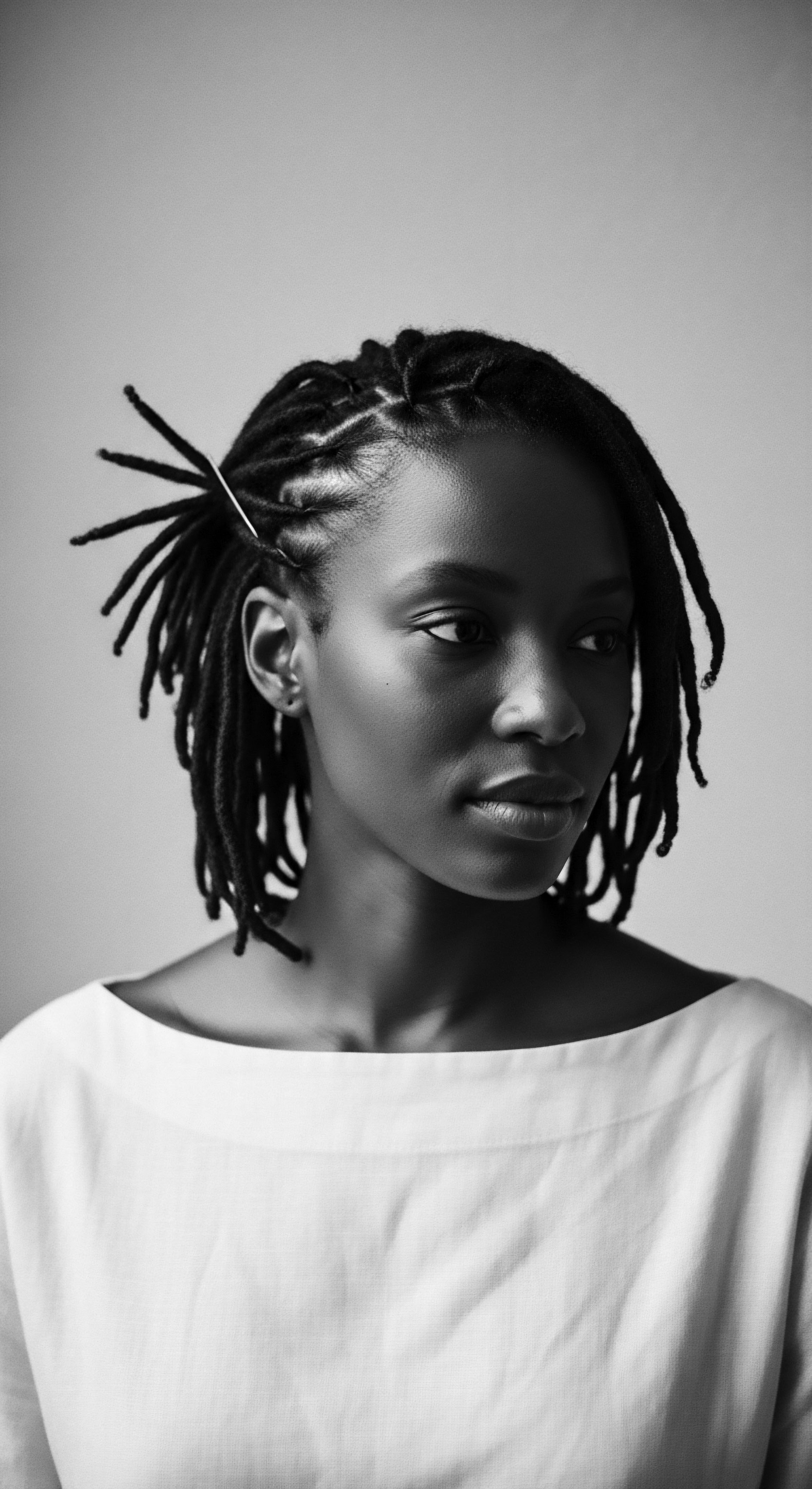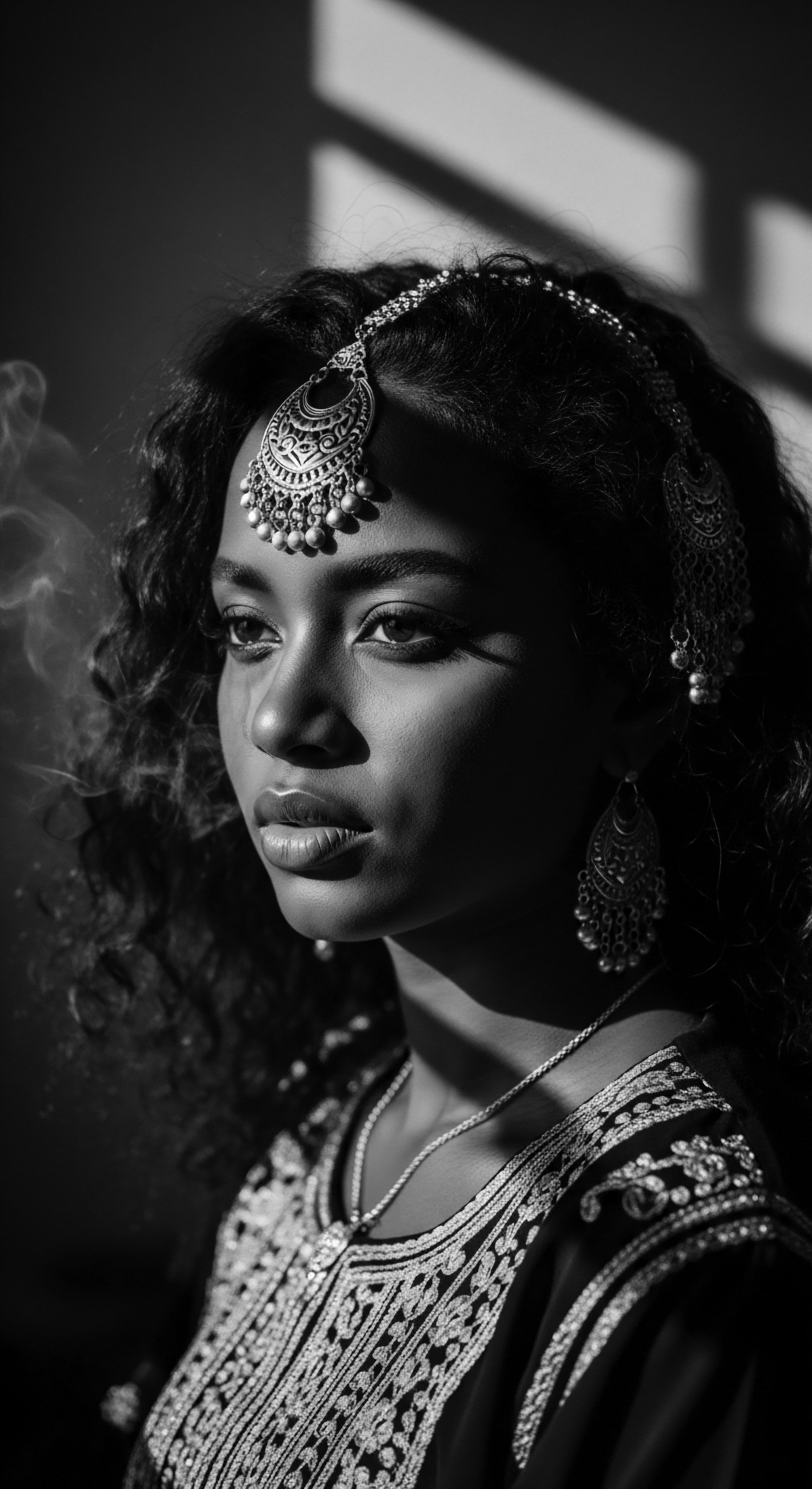
Roots
To stand here, at the threshold of understanding how hair binds communities, is to feel the subtle tremor of ancient earth beneath one’s feet, to hear the soft rustle of leaves that speak of countless generations. For those whose strands coil and curve, whose textured hair holds the memory of sun-drenched lands and ancestral paths, this connection is not abstract. It resides in the very architecture of each individual fiber, in the rituals passed down through spoken word and gentle touch, and in the unspoken language woven into collective identity. Our journey begins at the source, acknowledging the elemental biology of textured hair and the enduring wisdom that has shaped its understanding across centuries, a profound ancestral legacy.

The Architecture of Ancestral Strands
The very physics of a textured hair strand differs considerably from its straighter counterparts. Its elliptical or flattened cross-section, coupled with an uneven distribution of keratin, dictates its characteristic coiling. These structural variations create points along the strand where it naturally bends and twists, contributing to its definition.
When considering hair health, this inherent geometry means that natural oils produced by the scalp find it harder to travel down the length of the strand, often leaving the ends prone to dryness. This biological reality has, through the ages, informed the development of care practices centered on moisture retention and gentle handling, practices honed by ancestral observation.
Beyond mere shape, the number of disulfide bonds within the keratin structure and their arrangement also influence elasticity and strength. Textured hair, particularly those with tighter curl patterns, possesses a unique resilience, capable of withstanding considerable manipulation when cared for appropriately. This intrinsic strength, often overlooked in Eurocentric beauty narratives, becomes a testament to the adaptive nature of these very fibers. The historical understanding of this resilience, not as fragility but as robust design, is a key component of the inherited wisdom surrounding textured hair care.
The intrinsic design of textured hair informs ancient practices and reveals its deep-seated resilience.

Naming the Patterns How Did Ancestors Describe Curl?
For generations, the nuanced language for describing hair texture existed within communities, often passed down informally, through terms that reflected lived experience and direct observation. These vernacular descriptions were not sterile classifications but living descriptors, embedded in conversations about hair care, styling, and communal recognition. The formal systems of classification, such as Andre Walker’s typing system or the more recent Loctician’s scale, arose from a different context, often seeking to categorize and market. The ancestral approaches, however, focused on practical understanding for everyday care and collective grooming, where distinctions were made for functional purposes rather than for rigid categorization.
- Coil ❉ Often used to describe very tight, spring-like patterns that form small, circular spirals.
- Kink ❉ A term sometimes employed to represent sharp, zig-zag bends in the hair, creating a dense, voluminous appearance.
- Curl ❉ A more general term for hair that spirals, often encompassing looser patterns.
- Wave ❉ Hair that forms an ‘S’ shape, less tightly wound than a curl but still possessing movement.

The Living Language of the Strand
The lexicon surrounding textured hair has always been a dynamic one, shifting with time and context, yet always holding threads of ancestral continuity. Words like Braid, Loc, Cornrow, and Twist are not simply technical terms; they are verbs and nouns that carry the weight of tradition, of hands meeting hair, of shared time and space. These terms, often specific to Black and mixed-race communities, serve as more than just descriptions of styles; they are acknowledgements of techniques that have sustained cultural identity through eras of oppression and celebration. This language, transmitted orally for centuries, became a means of preserving skill and cultural practice.
Consider, for a moment, the significance of the term “tender-Headed.” This is not a scientific diagnosis; it is a communal acknowledgment of a shared experience, a recognition of the sensitivity often associated with textured hair, particularly when detangling or styling. It speaks to a collective empathy and the gentle care required, lessons passed from elder to child. This lexicon helps define not only the hair itself but also the emotional and relational landscape surrounding its care, reinforcing the bonds within the community.

Ancestral Rhythms of Growth
Hair growth, a ceaseless biological rhythm, proceeds through distinct phases ❉ Anagen (growth), Catagen (transition), and Telogen (resting/shedding). For textured hair, this cycle often appears elongated in the anagen phase for many individuals, allowing for impressive lengths, though the appearance of length can be masked by the curl pattern itself. Historically, the understanding of these cycles was not rooted in scientific terminology but in observation.
Ancestors understood that certain seasons or life stages influenced hair’s vitality. They noticed patterns of shedding, linking them perhaps to diet, climate, or life’s stresses, and adapted their care practices accordingly.
Environmental factors, certainly, played a significant role in ancestral hair health. Access to nutrient-rich foods, exposure to diverse climates, and the availability of natural ingredients all influenced the vitality of the hair. Hair, in this sense, became a barometer of overall well-being, reflecting the nourishment received from both the earth and the community. This holistic view, where hair health was inseparable from general health and environmental harmony, remains a central tenet of traditional wisdom regarding hair care.

Ritual
From the very beginning, styling textured hair was seldom a solitary act. It was a practice imbued with intention, a conduit for intergenerational transmission, and a vibrant expression of identity. These practices, whether intricate braiding patterns or the careful application of natural elixirs, were not merely cosmetic.
They were deeply embedded within the fabric of daily life, connecting individuals to their lineage and to the collective spirit of their people. This communal engagement with hair, spanning centuries, forms a rich heritage of shared experiences and collective artistry.

Styling as a Collective Memory How Do Styles Carry Stories?
The protective styles so prevalent in textured hair communities—Cornrows, Braids, and Twists—are more than just aesthetic choices or practical means of managing hair. They are living archives, carrying with them centuries of innovation, symbolism, and survival. In many West African societies, for example, intricate braiding patterns conveyed age, marital status, tribal identity, and even social rank.
These designs were often specific to certain occasions or ceremonies, acting as a visual language understood by the community. The act of creating these styles became a moment of shared storytelling, where elders would share histories, proverbs, and lessons with the younger generation seated between their knees.
During the transatlantic slave trade, and in its aftermath, these styling traditions played a critical role in preserving cultural continuity. Enslaved Africans, stripped of their names, languages, and lands, held onto hair practices as a profound act of resistance and memory. Braids were used to map escape routes, with seeds and even gold sometimes hidden within the intricate patterns, a silent communication of resilience and survival (Byrd & Tharps, 2014, p.
19). This serves as a powerful historical example of how hair, through its styling, served as a means of communication, resistance, and communal cohesion, embodying an unwavering connection to ancestral practices even in the face of unimaginable adversity.
Hair styling, especially protective patterns, acts as a living archive of community history and cultural identity.

The Hands That Tend The Legacy of Touch
The communal aspect of hair care extends to the very touch. Hair washing, detangling, oiling, and braiding were, and in many communities still are, shared experiences. Mothers, aunts, grandmothers, and friends would gather, their hands working in tandem, transforming a functional task into a social ritual. This collective effort fostered intimacy, creating spaces for gossip, advice, laughter, and the quiet comfort of presence.
The tender care applied to one another’s hair built trust and reinforced familial and communal bonds. It was a tangible expression of love and care, a non-verbal affirmation of belonging.
The tools employed in these rituals also carry a history. From hand-carved combs of wood or bone, designed to gently navigate the coils and curves, to natural fibers used for extensions, these implements were often crafted within the community, embodying a deep understanding of the hair’s unique requirements. The knowledge of which plant-based oils to use for moisture, which herbs for scalp health, and how to combine them into potent elixirs was accumulated over centuries, passed down from one generation to the next. This shared wisdom became a practical guide for maintaining hair vitality, drawing from the ancestral wellspring of natural remedies.
| Ancestral Practice Co-washing with natural clays or plant extracts |
| Purpose and Community Connection Gentle cleansing and moisture retention, often done communally, sharing resources. |
| Contemporary Parallel/Understanding Modern co-washing conditioners; emphasis on low-lather cleansing for moisture preservation. |
| Ancestral Practice Hair oiling with indigenous plant oils (e.g. shea, coconut, castor) |
| Purpose and Community Connection Scalp nourishment, strand protection, often a shared ritual of care. |
| Contemporary Parallel/Understanding Wide array of hair oils and serums; scientific validation of lipid benefits for hair. |
| Ancestral Practice Protective styling (braids, locs, twists) |
| Purpose and Community Connection Hair preservation, identity marker, communal artistry, communication of status/belonging. |
| Contemporary Parallel/Understanding Popularity of protective styles for length retention and versatility; celebration of cultural aesthetics. |
| Ancestral Practice These practices reveal an unbroken lineage of textured hair care, adapting through time while maintaining their core principles. |

A Language of Adornment When Did Hair Tell A Story?
Adornment of textured hair extends beyond just styling. Beads, cowrie shells, gold, and other precious materials were woven into hair, serving as powerful symbols. In some African societies, cowrie shells signified prosperity or fertility, while certain bead colors communicated messages or group affiliations.
These embellishments were not random additions; they were deliberate choices that communicated status, identity, and aspirations to the wider community. The adornment became another layer of the hair’s story, a visual narrative that deepened its connection to collective meaning and shared heritage.
The act of adding these adornments, much like styling itself, was often a collaborative effort, involving skilled hands and collective appreciation. The careful placement of each bead or shell transformed the hair into a living sculpture, a work of art that was appreciated and understood by those who shared the cultural vocabulary. This historical interplay between hair and adornment reveals a profound aesthetic sensibility, where hair was recognized not just as a biological outgrowth but as a powerful medium for cultural expression.

Relay
The journey of textured hair, from ancient practices to contemporary expressions, is a powerful testimony to continuity and adaptation. It is a constant relay of wisdom, a passing of the torch from one generation to the next, often against tides of adversity. In this relay, hair becomes a potent symbol, a canvas for identity, and a rallying point for collective action, particularly within Black and mixed-race communities. The complexities surrounding hair, its presentation, and its acceptance reveal deeper societal currents and the enduring power of ancestral ties.

Hair as Resistance How Does Hair Challenge Power Structures?
Throughout history, textured hair has consistently served as a site of both personal agency and collective resistance. During periods of enslavement and colonialism, efforts were made to suppress traditional hair practices, viewing them as “savage” or “unclean,” aiming to strip individuals of their cultural identity. Yet, the persistence of braiding, locs, and natural styles, often performed in secret, became a quiet yet profound act of defiance. This historical struggle for the right to wear one’s hair in its natural state, or in traditionally Black styles, continued well into the 20th century and beyond, epitomized by the Civil Rights and Black Power movements.
The Afro, in particular, during the 1960s and 70s, became an unmistakable symbol of Black pride, self-acceptance, and political assertion (Mercer, 1994, p. 100). Wearing an Afro was a public rejection of imposed Eurocentric beauty standards and a reclaiming of an ancestral aesthetic.
It was a visible declaration of identity that resonated deeply within the community, fostering solidarity and challenging oppressive norms. This period marks a critical instance where hair became a direct emblem of a collective struggle for dignity and recognition, moving beyond individual preference to become a political statement.
Textured hair, historically and presently, functions as a powerful symbol of resistance against imposed norms.

Shaping Future Narratives What Is Hair’s Role In Youth Identity?
Today, the conversation around textured hair continues to evolve, shaped by increased visibility, social media, and a growing understanding of hair science. The natural hair movement of the 21st century, for example, marks a renewed commitment to embracing natural textures and traditional care methods, echoing ancestral wisdom in a modern context. This movement has been instrumental in creating new communities of support, where individuals share styling tips, product recommendations, and personal narratives, solidifying collective bonds through shared hair journeys.
For younger generations, textured hair is not just about aesthetics; it is deeply tied to self-perception and belonging. Schools and workplaces grappling with hair discrimination laws, such as the CROWN Act in the United States, reflect an ongoing societal struggle to fully accept and celebrate textured hair in all its forms. These legal battles are not merely about preventing discrimination; they are about affirming the right to cultural expression and challenging systemic biases that have historically marginalized Black and mixed-race hair. The outcome of these efforts directly influences how future generations will perceive and wear their hair, influencing their sense of identity and community.
- CROWN Act ❉ Legislates against discrimination based on hair texture and protective hairstyles associated with race.
- Online Hair Communities ❉ Digital spaces where individuals share knowledge, support, and cultural connection related to textured hair.
- Celebrity Influence ❉ Public figures showcasing natural and traditional styles, normalizing and celebrating textured hair in mainstream media.

The Interconnected Helix Understanding Health and Heritage
Modern scientific understanding now validates many long-held ancestral practices. The effectiveness of natural oils in sealing moisture, the benefits of protective styling for length retention, and the gentle approach to detangling are all principles that science now supports. This convergence of ancient wisdom and contemporary research creates a more holistic view of textured hair care, one that honors heritage while also leveraging new knowledge.
The hair industry, though historically a source of both innovation and cultural appropriation, is slowly shifting to better serve the needs of textured hair. This shift is driven, in part, by the persistent advocacy of communities who demand authentic products and respectful representation. As consumers become more informed and empowered, they champion brands and practices that truly respect the unique requirements and cultural significance of textured hair. This ongoing dialogue between community, science, and industry ensures that the legacy of textured hair continues to evolve, remaining connected to its deep roots while reaching towards a more inclusive future.

Reflection
The story of textured hair is, at its heart, a story of connection. It is the palpable link between generations, a vibrant echo of ancestral practices, and a living testament to resilience. Each coil, each kink, each wave carries within it not just biological code, but the rich legacy of collective experiences, of communal care, and of unwavering spirit. From the earliest communal grooming sessions under African skies to the contemporary digital spaces where care rituals are shared, hair has remained a profound conduit for human connection.
It reminds us that our personal strands are never truly separate from the vast, interconnected web of those who came before us, and those who will follow. This ongoing journey, a beautiful, evolving archive, continually reminds us of the profound truth ❉ the soul of a strand is forever bound to the soul of its community.

References
- Byrd, A. D. & Tharps, L. (2014). Hair Story ❉ Untangling the Roots of Black Hair in America. St. Martin’s Griffin.
- Mercer, K. (1994). Welcome to the Jungle ❉ New Positions in Black Cultural Studies. Routledge.
- Roberts, T. L. (2003). Black Hair ❉ Art, Culture, History. Rizzoli.
- Speller, D. A. (2020). Hair Like Ours ❉ The Power, Beauty, and Resilience of Black Hair in America. Abrams Books for Young Readers.
- Akbar, N. (1998). The Nature of Human Personality. World Changers Publishing.
- Harris, K. (2019). The Culture of Curls ❉ A History of Natural Hair in America. University of Illinois Press.
